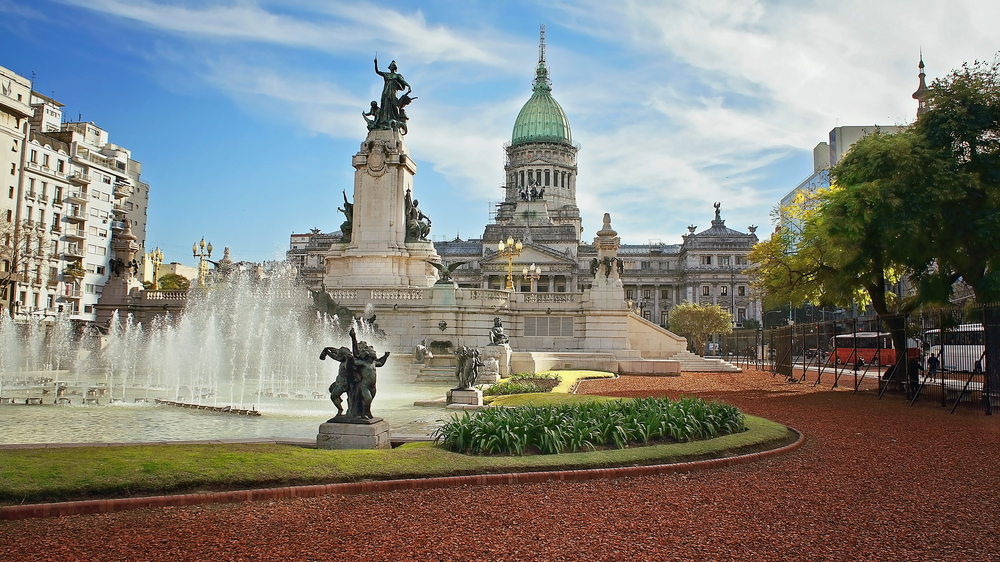“Che boludo!” The word boludo is the second most used word in Argentine Spanish. Literally translated, it means something like -idiot-. Mostly, however, this is used with a friendly undertone, often in combination with che – “che boludo” – and then means “Hey buddy”. Buenos Aires is a colorful, crazy and lovable city in its own way. As the capital of Argentina with almost 3 million inhabitants, a total area of 203 km² and its extraordinary architecture, it is not for nothing that it is called the Paris of Latin America.
At the same time, Buenos Aires is also the industrial and commercial center of Argentina. The name Buenos Aires comes from Santa Maria del Buen Aire, the patron saint of seafarers. The official name of the city is Ciudad Autonoma de Buenos Aires.
In the footsteps of Pope Francis, Maradona and Co.
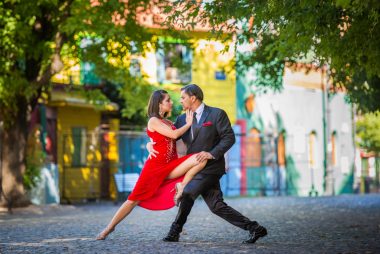
When you think of Buenos Aires, terms like tango, asado and gaucho immediately come to mind. But Buenos Aires has many other facets. From simple clay houses to gigantic luxury buildings, colorful street markets to elegant shopping centers and small fishing villages all the way to Paris. Argentina is a popular travel destination and Buenos Aires is the perfect starting point from which to explore the country.
There are many direct flights to Buenos Aires and after only 13 hours you can follow in the footsteps of Pope Francis, Maradona and Co. For this, it is recommended to plan at least 3 days in Buenos Aires. The city’s landmarks are almost all located in the Microcentro. The Plaza de Mayo represents the heart of the Argentine capital. It is still the centre of political demonstrations and national festivals today. The historic landmarks around the square refer to the eventful history of Buenos Aires and all of Argentina.
Getting around Buenos Aires
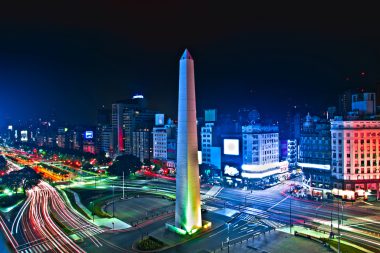
Directly on the Plaza de Mayo is the Casa Rosada, the palace of the president. A flag under the national flag indicates whether the president is currently on site. Why the Casa Rosada is pink right now, every “Porteño” (inhabitant of Buenos Aires) probably has his own story about it. Opposite is the Old City Hall of Buenos Aires, in which there is a museum about the history of the city. If you continue along Avenida de Mayo, it intersects with Avenida 9 de julio after only a few “cuadras”. It is 140 meters wide and consists of more than 16 lanes, making it the widest road in the world.
Its name commemorates Argentina’s Independence Day, July 9, 1816. In the middle of the street is the obelisk. A 67-meter-high monument, which was erected in May 1936 on the occasion of the 400th anniversary of the founding of the city. The Teatro Colón, the most famous theater in Buenos Aires, is also located directly on Avenida 9 de Julio. If you continue along Avenida de Mayo, you will pass the Palacio Barolo, another landmark of the city. At the end of the Avenida is the congress. The square in front of it also represents km 0 of Buenos Aires and is therefore often the starting point of many free walking tours.
Other neighborhoods worth visiting include
Palermo
, with its beautiful graffiti and bar scene. In addition, you will find an oasis of peace in the middle of the city. The Bosque de Palermo is a pretty park that offers a retreat during the day. Another neighborhood is Recoleta, whose building originally gave Buenos Aires its name “Little Paris.” This is probably the most famous cemetery in the world, where the resting place of Evita (Eva Perón) can be found, among other things.
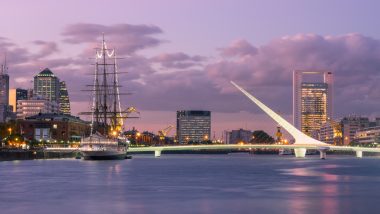
Finally, two other neighbourhoods stand out: San Telmo and La Boca. The flea market in San Telmo is probably one of the most famous in all of Latin America. Every Sunday, a huge market walks along the entire Calle Defensa (from Plaza de Mayo). There is something for everyone here. From antiques to souvenirs, small food stalls and folklore dancers on the street. La Boca is the city’s original working-class neighborhood. Around the Caminito, a narrow colorful alley with beautiful corrugated iron houses, there are dozens of street performers and every corner in this neighborhood is a photo backdrop in itself.
Even Francis waves down from a balcony. La Bombonera is the home stadium of Boca Juniors football club and on match days it is pure chaos. However, if you have the opportunity to go to a game (maybe even against Riva Plate (derby!!) you should not miss this chance. Otherwise, however, there is still the alternative of taking a picture with Maradona, who can be found as a cardboard figure directly in front of the stadium. Last but not least, Retiro should be mentioned. Retiro is the hub of the city. From here – whether by bus or train – you can travel through Argentina the cheapest and fastest.
Una Milanesa por favor and a tango!
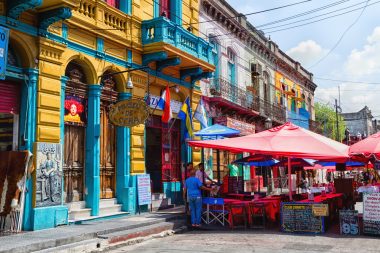
It’s hard to believe, but Argentines eat more schnitzel than we Germans. On every menu in Buenos Aires there is at least one dish with Milanesa (German: Schnitzel) and in the craziest combinations. Otherwise, Buenos Aires is of course known for its asado (grilled meat). The national dish, however, remains the choripán – chorizo in a bun with chimichurri-. Pizza and ice cream are also part of Buenos Aires, like sand to the sea; Thanks to the Italian influence and the international character. To top it off, alfajores – Argentina’s most famous dessert – are not to be missed.
Well fortified, you should not miss the numerous evening events in Buenos Aires. On every corner you can discover a small tango bar and there are also many dance schools that offer courses for little money. Otherwise, Buenos Aires is known for its theater performances. If you are looking for something out of the ordinary, it is recommended to go to the Teatro Ciego. The theater in Buenos Aires is one of the few theaters for the blind in the world and a unique experience. Other extravagant productions are -La bomba del tiempo- and -Fuerza Bruta-. Indescribable, provocative and extraordinary.
Bueonos Aires – Immerse yourself in a secret world
Finally, an absolute insider tip for Buenos Aires. There are countless secret bars that are not only constantly changing their cocktail menu, but also their location. Currently, the following “Secret Bars” are definitely worth a drink:
- Floreria Atlántico
The -Floreria Atlántico- is considered an undisputed classic among secret bars. If the beautiful flower shop itself has already closed, you can come down a staircase through a secret passageway and find an elegant bar where not only suit wearers get their money’s worth.
- Uptown
An old subway station converted into a stylish bar? –Uptown- makes it possible. Not only are the drinks something for the eye here, but the different people also make the bar an unforgettable experience.
- Harrison’s Speakeasy
You can experience a journey through time at record speed in the -Harrison ́s Speakeasy-. From the outside a normal sushi shop, from the inside a bar from 1920 in the middle of Manhattan. Accompanied by a waitress, you walk through the wine cellar and immerse yourself in a long-forgotten world: music, drinks and interior design, all in the flair of the 20s in New York.


